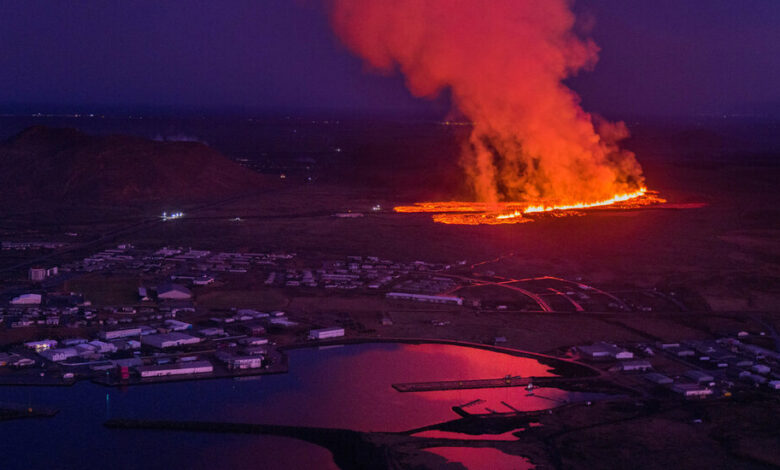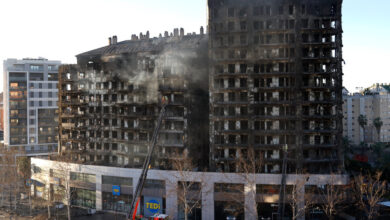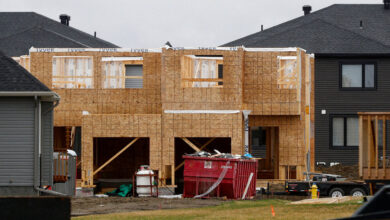
[ad_1]
Living in a country that straddles two tectonic plates and has 130 or so volcanoes, Icelanders are no strangers to earthquakes and eruptions.
But a lava stream that flowed into the southwestern town of Grindavik on Sunday, burning three homes — the first time in about 50 years that a residential area had been affected — was further proof that a threatening new phase of seismic activity had started in the area, according to Iceland’s president.
“A daunting period of upheaval has begun on the Reykjanes Peninsula,” the president, Gudni Johannesson, said in a televised address on Sunday night, referring to the area that includes Grindavik. “What we all hoped would not happen has come to pass.”
Since 2020, scientists have seen signs of increased volcanic activity on the Reykjanes Peninsula, which had been dormant for 800 years, and they have detected tens of thousands of earthquakes in recent months. In response to a potential eruption, Iceland has built defensive barriers around a geothermal power plant, which supplies hot water to the area, and around other potentially vulnerable sites nearby.
Grindavik, a fishing town of 3,600 people, was evacuated in November after strong seismic activity was recorded on the peninsula, then again in December, when a stream of lava erupted in a remote valley north of Grindavík for several days, without causing damage. Residents were advised not to return to their homes, and before the eruption on Sunday, the authorities ordered a complete evacuation of the 200 people who had remained.
A volcanologist at the University of Iceland, Thorvaldur Thordarson, said on Monday that the threat to the peninsula, where about 31,000 residents live in several towns, would not end soon.
“This new chapter on the Reykjanes Peninsula will last for a long time,” he said, adding, “A large, populated area is at stake.”
The scorching orange stream of lava that poured out of a fissure on Sunday, descending on Grindavik, has left a question mark over when residents there might return.
Iceland’s prime minister, Katrin Jakobsdottir, said on Monday that the evacuation of Grindavík’s residents — who represent 1 percent of Iceland’s total population of about 370,000 — is a major task, and that the authorities had to start thinking about “long-term solutions.”
“It was one of the biggest natural disasters we have seen in recent times,” Ms. Jakobsdottir said in a phone call. “The events are part of a larger picture, which will be with us for the future to come.”
Still, residents, even those who had their homes destroyed, hoped that they would eventually be able to go back. The earthquakes have also damaged dozens of buildings and roads in the town, and a construction worker last week fell through a crack and died.
Unndor Sigurdsson, a schoolteacher and a father of three, had recently built his house in Grindavik, in part with his own hands. He visited it last week, and he was planning to return to Grindavik soon. But on Sunday, Mr. Sigurdsson and his family watched their house go up in flames on livestream from a flat in Reykjavik.
“The fissure opened up like a straight arrow toward my house,” Mr. Sigurdsson, who coaches Grindavik’s basketball team, said in a phone call on Monday. “This morning, the video shows only a black layer of lava.” He added, “It is like my house was never there.”
But he said that he is still going to return. “When it is possible, and allowed,” he said. “I will move back to Grindavík.”
Fannar Jónasson, the mayor of Grindavík, said that they were monitoring the volcanic activity day by day and building action plans.
“There is hope that our community in Grindavík will rebuild quickly,” he wrote in an email. “But as things stand, you can’t say anything for sure, you can only hope.”
Hordur Gudbrandsson, 63, leader of a local labor union, said that, before Sunday’s lava flow, business owners in Grindavik had been planning to reopen.
“The eruption has changed the tone,” said Mr. Gudbrandsson. “For how long, I don’t know.”
Grindavik’s population has boomed in recent years thanks to an influx of people from the capital, Reykjavik, which is only a 45-minute drive away. As well as commuting jobs, residents could find work at the geothermal plant, in the fishing industry or at the Blue Lagoon, a geothermal spa popular with tourists.
Tourism in Grindavik has been further boosted by frequent eruptions at the Fagradalsfjall mountain ridge, where the Reykjanes Peninsula first flared to life in 2021, after centuries of calm. But now, the volcanoes are threatening the town.
Mr. Gudbrandsson said he was concerned about the future of the town, but he noted that, for a community that traditionally made its living on fishing boats in the stormy North Atlantic, facing up to adversity was a common trait.
Bad news about sinking ships and drownings have always been part of life, he said: “We know how to stand together.”
Vilhjalmur Arnason, a lawmaker and resident of Grindavik, said he was sure that residents would return. He cited an eruption of the Eldfell volcano in 1973, which dumped ash and lava over much of Heimaey, in the Westman Islands off southern Iceland, destroying several hundred homes. Many residents eventually went back to the island.
“If you live in Iceland,” Mr. Arnason said, “You have to manage to live with the nature.”
Source link




